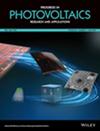碲化镉薄膜光伏系统的最新可持续发展状况和预测
摘要
本文对基于碲化镉的光伏(PV)系统的最新生命周期可持续性状况进行了全面评估。本文分析了当前生产的组件(6 系列和 7 系列)的能源性能和环境足迹,并与较早的 4 系列组件生产和当前的单晶硅(sc-Si)组件生产进行了比较。使用 6 系列组件的固定倾角系统在美国平均辐照度 1800 千瓦时/平方米/年的条件下运行时,全球升温潜能值 (GWP) 从 4 系列系统的 16 克 CO2eq/kWh 降至 6 系列系统的 10 克 CO2eq/kWh。在美国西南部辐照度为 2300 千瓦时/平方米/年的地区运行时,全球升温潜能值从 11 克 CO2eq/kWh 降至 8 克 CO2eq/kWh;在亚利桑那州凤凰城运行的单轴跟踪系统,阵列点辐照度为 3051 千瓦时/平方米/年,全球升温潜能值降至 6.5 克 CO2eq/kWh。所有环境指标都有类似的降低。考虑到平均化石燃料主导的电网,燃料到电力的转换效率为 0.3,目前安装的系统的能源投资回收期(EPBT)从美国平均辐照度下的固定倾斜地面安装的 0.6 年到美国西南高辐照度下的单轴跟踪器的 0.3 年不等。由此产生的能源投资回报率(EROI)还取决于电网的转换效率和预期运行寿命。在运行寿命为 30 年、电网转换效率为 0.3 的情况下,EROI 介于 50(美国平均辐照度)到 70(美国-西南辐照度)之间。随着电网转换效率的提高,其 EROI 会下降;在南加州运行的碲化镉光伏发电的电网转换效率为 49%,其 EROI 约为 50,预计在该州 2030 年可再生能源渗透率达到 80% 的目标时,其 EROI 将降至 30。此外,还研究了可进一步降低降解率的材料替代品,以及可延长运行寿命的增强封装材料。在 30 年方案中,假设降解率为 0.3%/年(已通过加速测试验证);预计在短期内降解率将降至 0.2%/年,在长期内可能降至 0.1%/年。有了如此低的降解率和更强的边缘密封性,模块的使用寿命可达 40 至 50 年。因此,所有影响指标都将按比例降低,而 EROI 将增加。这项详细的生命周期评估是根据 ISO 标准和国际能源署 PVPS 任务 12 指南进行的。研究表明,系统模型、方法和时间系统边界的选择会对结果产生重大影响,并指出有必要将有关这些选择的假设纳入国际能源署 PVPS 第 12 项任务指南所列的 "报告透明度 "要求中。

This paper provides a comprehensive assessment of the up-to-date life-cycle sustainability status of cadmium-telluride based photovoltaic (PV) systems. Current production modules (Series 6 and Series 7) are analyzed in terms of their energy performance and environmental footprint and compared with the older series 4 module production and current single-crystalline Silicon (sc-Si) module production. For fixed-tilt systems with Series 6 modules operating under average US irradiation of 1800 kWh/m2/year, the global warming potential (GWP) is reduced from 16 g CO2eq/kWh in Series 4 systems to 10 CO2eq/kWh in Series 6 systems. For operation in US-SW irradiation of 2300 kWh/m2/year, the GWP is reduced from 11 to 8 CO2eq/kWh and for 1-axis tracking systems operating in Phoenix, Arizona, with point-of array irradiation of 3051 kWh/m2/year the GWP is reduced to 6.5 CO2eq/kWh. Similar reductions have happened in all environmental indicators. Energy payback times (EPBT) of currently installed systems range from 0.6 years for fixed-tilt ground-mounted installations at average US irradiation at latitude tilt installations to 0.3 years for one-axis trackers at high US-SW irradiation, considering average fossil-fuel dominated electricity grids with fuel to electricity conversion efficiency of 0.3. The resulting energy return on energy investment (EROI) also depends on the conversion efficiency of the electricity grid and on the operation life expectance. For a 30-year operational life and grid conversion efficiency of 0.3, EROI ranges from 50 (at US average irradiation) to 70 for US-SW irradiation. The EROI declines with increased grid conversion efficiency; for CdTe PV operating in south California with grid conversion efficiency of 49%, the EROI is about 50 and is projected to fall to 30 when the state's 2030 target of 80% renewable energy penetration materializes. Material alternatives that show a potential of further reductions in degradation rates and materials for enhanced encapsulation that would enable longer operation lives have also been investigated. A degradation rate of 0.3%/year, which has been verified by accelerated testing, is assumed in 30-year scenarios; this is projected to be reduced to 0.2%/year in the near-term and potentially to 0.1%/year in the longer term. With such low degradation rates and enhanced edge-sealing, modules can last 40- to 50-years. Consequently, all impact indicators will be proportionally reduced while EROI will increase. This detailed LCA was conducted according to ISO standards and IEA PVPS Task 12 guidelines. The study revealed that the choices of system models, methods and temporal system boundaries can significantly impact the results and points out to the need to include assumptions regarding these choices in the “transparency in reporting” requirements listed in the IEA PVPS Task 12 Guidelines.

 求助内容:
求助内容: 应助结果提醒方式:
应助结果提醒方式:


